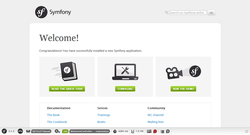Symfony
 Symfony default project | |
| Developer(s) | Sensio Labs |
|---|---|
| Stable release | 1.0.9
/ November 29, 2007 |
| Repository | |
| Operating system | Cross-platform |
| Type | Web application framework |
| License | MIT License |
| Website | symfony-project.com |
Symfony is a web application framework written in PHP which follows the model-view-controller (MVC) paradigm. Released under the MIT license, Symfony is free software. The symfony-project.com website launched on October 18, 2005.[1]
Goal
Symfony aims to speed up the creation and maintenance of web applications and to replace repetitive coding tasks. It requires few prerequisites for installation: Unix, Mac OS or Microsoft Windows with a web server and PHP 5 installed. It is compatible with many relational database management systems, and has low performance overheads.[2]
Symfony is aimed at building robust applications in an enterprise context, and aims to give developers full control over the configuration: from the directory structure to the foreign libraries, almost everything can be customized. To match enterprise development guidelines, Symfony is bundled with additional tools to help developers test, debug and document projects.
Learning curve
Proponents of the framework claim that the learning curve required for its proficient use is reduced to less than a day. It is designed to allow developers to apply agile development principles (such as DRY, KISS or the Extreme Programming philosophy) and focus on applicative logic without needing to write the many XML configuration files expected of contemporary frameworks.
Sponsors
Symfony is sponsored by Sensio, a French Web Agency.[3] The first name was Sensio Framework[4], and all classes were prefixed with sf. Later on when it was decided to launch it as open source framework, the brainstorming resulted in the name Symfony, the name which depicts the theme and class name prefixes.[5]
Real-world usage
Symfony is used by the open-source Q&A service Askeet and many more applications, including the 20 million users of Yahoo Bookmarks.
See also
References
Further reading
- Potencier, Fabien and Zaninotto, François. (2007). The Definitive Guide to Symfony. Apress. ISBN 1590597869.
